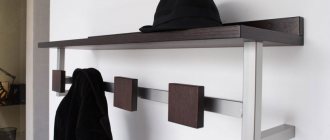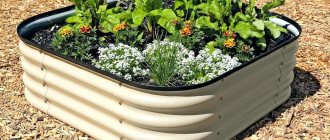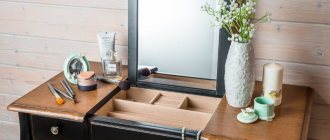Home » Type » Dacha
DachaDecor
Alyona
How to properly plant flowers in your dacha to give your dacha incredible charm? Secrets that everyone should know about. Everything will be discussed in more detail later in the article.
Landscape design of a dacha
At first glance, it may seem that it is much easier to develop a landscape design for a large summer cottage than for a small one. But in reality this is far from the case. By choosing them incorrectly or placing them incorrectly, you can visually “reduce” your already small summer cottage plot.
Bright landscape for a summer residence
To prevent this from happening, you need to follow a few simple tips:
1The first rule is to avoid large buildings, trees and shrubs. Large plants take up a lot of space, which will make it seem like the dacha is quite “tiny.”
2It is necessary to abandon high hedges completely entwined with climbing flowers. If the area is completely fenced off and a large number of flowers are planted around the fence, it will look more like a cage than a place to rest.
3You should not plant tall flowering trees in your dacha. Because of them, the area will be completely darkened, and most will not be able to grow in such conditions. You can, of course, plant the entire dacha plot with shade-loving flowers. But most of them practically do not bloom, and will also not be able to grow if the soil has a low level of acidity and humidity.
Design your own landscape design
Rules of composition
Five basic rules of landscape composition are all you need to know to create a harmonious landscape.
Dominant, accent, background
The dominant (base) of any site is the house, and the garden is its harmonious continuation. Both the house and the garden should be made in the same style. If the styles are different, a feeling of discomfort invariably arises - there is no harmony. And in this case, it will not be possible to create an effective landscape design. Even expensive exotic plants will not help.
Create major and minor elements. Looking at various flower beds, we concentrate our gaze on color, shape, size and other planting accents
Accents are considered to be groups of large or bright trees and shrubs. In other words, it is something that attracts attention, something that you want to look at. They are present in any landscape. Often the emphasis is on the source of water: pond, stream, fountain - it doesn’t matter.
Important: there should not be too many accents, otherwise they will cease to be so. And the entire site will turn into a collection of all kinds of plants and small architectural forms.
The dominant feature on any site will be the house. The garden is an extension of the house. The house and garden should be in the same style.
The background is very important for composition in landscape design. Agree, even the most spectacular composition will not look very good, to put it mildly, against the backdrop of a rotten fence or beds. But if a hedge, a well-groomed lawn or a view of the forest is chosen as the basis of the composition, the area will sparkle with new colors.
The principle of nuance
In simple terms, all “representatives” are united by a common feature: color, shape or size. For example, a mixed flower garden of pink perennial crops. Or, a flower bed of clipped round-shaped plants of different sizes.
The composition is based on the principle of nuance, when the constituent elements are similar to each other.
Contrast
Another way to create an effective composition is to play with contrast. Colors that are opposite on the color wheel are considered contrasting. They have a wonderful property - the ability to strengthen each other. For example, red and green, purple and yellow, blue and orange. When combined with each other, these colors appear brighter than they really are. And even if there is little color, it is guaranteed to be noticeable against a contrasting background.
Plants can be contrasting not only in color, but also in shape.
Sometimes a mistake is made: contrasting colors are used in equal quantities. This is wrong: when playing on contrast, you should take more of one color than the other. This is explained simply: if you take plants of the same size but contrasting in color, a harmonious composition will not work, since the optical balance will be disturbed.
Contrasting colors have this wonderful quality: they enhance each other's effect.
Another point that is taken into account when playing on contrast: you cannot place groups of plants with contrasting colors nearby; there must be a neutral background.
In addition, not only color, but also shape can be contrasting. For example: cone-shaped and spherical or columnar and prostrate forms of plants. You can also play with contrast using the texture of plants: fluffy or with smooth leaves.
Plants with contrasting shapes are cone-shaped and spherical, columnar and spherical, columnar and prostrate.
The principle of an equilateral triangle
This rule is relevant not only for those involved in landscape design. It is used by photographers, artists and florists. Plants (by the way, this also applies to small architectural forms) are placed in such a way that you can see the outlines of an unequal triangle. This is done like this: one plant (at one of the vertices of the triangle) will be the tallest, the second will be lower, and the third will be the lowest.
Plants or small architectural forms are placed in such a way that an unequal triangle is visible along the contour.
At the same time, the triangle itself should not be straight, as this will interfere with the view, and one “vertex” will cover the other. And as a result, the group will not be obvious, which means there will be no composition.
If we take the triangle rule in general form, then it will be the rule of three. Three shapes, three sizes, three colors.
And even without taking into account the triangle as such, the rule of three remains in force. What does it mean? Three colors, three shapes, three sizes - this is the most harmonious “company”, no more, no less. For example, this principle is often used in the design of paths on a site: tiles of three colors, or stones of three sizes (large, medium, small).
One-way view
The composition of a one-way view in landscape design is the combination of plants and small architectural forms viewed from one side. For example, such “associations” are created near the wall of a house or near a fence. Such landscape design solutions look good against the backdrop of a hedge.
Most often, one-sided compositions are created against the wall of a house, a fence, or against the backdrop of a hedge.
However, it is not enough to plant the species you like in a certain order; it is also important to correctly calculate the optimal distance from the species point to the plants. Typically, it is equal to the largest height of the plant in the flower bed, multiplied by two (or two and a half). In other words, if the tallest shrub in the composition grows up to one meter, the best viewing point will be located at a distance of 2 or 2.5 m. Of course, if we are talking about tall trees (10 or more meters in height), this does not mean that you should only admire plants from 20 meters away. In this case, you will admire a picturesque fragment of a giant.
When conceiving a composition for a one-sided view, you can and should use plants of the same shape and size.
In order to obtain the effect of rhythm and integrity, plants of the same height and size are often used in one-sided compositions, and they are planted at the same distance from each other.
When composing a composition, you need to remember that some plants will dominate, others will act as a background.
It is possible to transform a suburban area into the garden of your dreams. Today, there are not only all the necessary tools for this, but also a large selection of beautiful plants. And taking into account the basic principles of landscape composition, you will make your dream come true.
Try to create a mixborder that matches the mood of the weather, and you will be surprised how beautiful it is!
We arrange flower beds. TOP 6 rules
To create an ideal one, you must adhere to the following rules:
1 varieties should be combined with each other not only in inflorescences, but in the shape of the leaves;
2 inflorescences and leaves that are different in shape, but similar in shade will look harmonious;
3 it is necessary to take into account the flowering period of each flower;
4 tall plants are planted in the center or on the last tier, low-growing ones - along the edges or borders;
5 in the center the distance between plants should be greater, closer to the edge the density increases. Plants planted near borders should be arranged in a “carpet”;
6It is not advisable to plant a large number of varieties with different shades of inflorescences nearby. So the flowerbed will look disharmonious;
7It is important to take into account preferences in soil, watering, amount of sunlight, soil acidity.
Consider the flowering period of all plants
Annual varieties
If everything is clear with perennials, which can grow in the same place for several years without requiring replanting, then annuals are a completely different matter. Annuals will have to be replanted every year.
Annuals for borders
On the one hand, this is an advantage, because if you don’t like a flower or don’t look good in the overall composition, then you can simply not plant it next year. But on the other hand, if it fits perfectly into the landscape design, then you will have to grow this variety every year.
Beautifully flowering annuals
| Annual name Flowering | July | Aug. Sept | October |
| Aster | + | + | |
| Marigold | + | + | + |
| Dahlia | + | + | |
| Gladiolus | + | ||
| Celosia | + | + | + |
| Purslane | + | + | |
| Clarkia | + | + | |
| Hypophylla | + | + | |
| Cosmea | + | + | + |
| Lavatera | + | ||
| Snapdragon | + | + | |
| Lobularia marine | + | + | |
| Nasturtium | + | + | |
| Petunia | + | + | |
| Sweet tobacco | + | ||
| Zinnia | + | + |
But among annuals you rarely find varieties that begin to bloom in early spring .
Most often, their flowering period begins in mid-summer and ends with the onset of the first frost.
Flower garden design
It must be said that the owners of plots prefer flowers for their dachas that do not require movement and are unpretentious to the weather, not only in May, June, July and August, but also in early spring. However, even before this, you will need to understand several important things, including such as choosing the right and suitable place for flower beds and flower beds, so that different plants fit well together in design. Now let's look at the main types of flower beds that you can choose for your summer cottage and garden.
By the way! A very successful option for a flower garden are pergolas and arches made on the site.
Beautiful country flower beds
If we consider the types of flower beds for flowers in the country, then among the most common of them are the following:
- Diamond-shaped.
- Round (the most common).
- Figured, the shape of which often depends on the surrounding topography.
- Strict square.
If we consider the height of the flower beds, then I would like to mention, first of all, flat and raised above the ground. Moreover, they do not rise by that much: a maximum of 0.2 meters. The edges of such flower beds can be additionally decorated using various finishing materials, including silicate and ceramic bricks, natural stone, and sidewalk curbs.
Original multi-level mixborder
Specialists in landscape design and planning call mixborders a special type of flower beds in which several flowers and other plants of different heights are used. Traditionally, it is customary to arrange mixborders against the background of some flat structural or decorative element, be it a small fence, a brick fence or a plank fence.
Such flower beds may change somewhat throughout the season, as some flowering plants are gradually replaced by new ones. The planting scheme for such flower beds can include both perennials and annuals. Moreover, decoration can be done using a combination of these two types of colors.
Lawns
If we talk about lawn-type flower beds, it should be noted that they are, at first glance, a somewhat unorganized planting. It rather resembles a forest clearing or a small area of natural meadow. On the other hand, the beauty of a lawn flower garden lies precisely in its natural beauty. Perfect for lovers of wildflowers (cornflowers, white and red clovers, immortelle, forget-me-nots, poppies, daisies). The peculiarity of such a flower bed is that all these flowers are very unpretentious and require practically no care.
Flower arches
The basis in such cases is special artificial structures made of wood or metal. As a rule, you need to plant different types of climbing plants. Examples include: climbing rose, decorative bean, clematis, ivy, virgin grapes, and so on.
Rabatka
This type of flower garden is a special strip of flowers, usually not wide (from 30 cm to one and a half meters). They can be placed along paths and parking lots, along the perimeter of the house (along the blind area) or next to the terrace. As a rule, when decorating a ridge, annuals are used, which form peculiar stripes. Shades can be used either contrasting or complementing each other. The height of plants can be either small or medium.
Creating monochrome compositions
Monochrome floral arrangements are very simple to design. The main condition is that everything must be in the same color scheme. You can use one or more plant varieties.
Monochrome floral arrangements
As in creating a round flower bed, tall plants are located in the center, followed by short ones. Ground covers can be planted along the edges.
Flowerbed with ground covers
If flowers grow near walls, fences or paths, the planting technique should be changed. Plant tall ones near the fence, and then you can plant low-growing plants.
Simple options for placing flowers in a flower bed
One of the simplest existing patterns for placing flowers in a flower bed is circular, since it is generally accepted that working on this type of flower bed is very simple.
The main thing that determines the result is how exactly the flowers will be placed. When choosing flowers for a flower bed, pay special attention not only to the color of the flowers, but also to their actual size.
You can place tall flowers in the center of the flowerbed, and very small ones at the edges. In the remaining space you can plant flowers that will bring you joy throughout the current season. Flowers such as begonia, marigolds and many others are ideal for this.
Flower beds that have an S shape look very beautiful. As a rule, such flower beds combine up to 3 shades of flowers. Plants are used in various sizes.
This type of flower bed not only looks attractive, but it is also quite easy to implement.
Contrasting compositions
Contrasting compositions will be no less effective. But creating one will be much more difficult. First of all, you need to understand exactly what colors are combined with each other, and based on this, plant.
Contrasting combination of colors and shades in the flowerbed
For example, you can choose shades from the same range. It can be yellow, red and orange. White, any other bright shades of inflorescences.
It is better not to combine roses with others and plant them separately.
It can be decorated like a mosaic. To do this, you need to select several different varieties and plant each variety together (in circles or any other shapes). The height of the stems should be approximately the same. The result should be one large flower bed consisting of small parts. You can plant low-growing greens (for example, hosta) along the edges.
Floral mosaic of tulips
Floral arrangements in a neutral style
Neutral floral arrangements look very minimalistic and impressive. To create such a composition, you will need several blooming varieties with dim inflorescences (pale pink, white, light yellow) and varieties that do not form inflorescences (fern, hosta). Such a flower bed will visually make the garden lighter and give it freshness.
Neutral floral arrangements
Neutral compositions can be created using roses. But in this case, it is advisable to give preference to pink, peach, and white varieties. Along with roses, you can also plant mock orange or lilac bushes.
Plant lilacs with roses
Seating of the most popular flowers
Most often, in summer cottages you can find roses, peonies, lilies or irises.
Lilies
As a rule, lilies are planted in large groups. You can plant low-growing Asiatic lilies in the foreground, which are the first to bloom. The second tier consists of tall varieties of lilies. Between these two tiers it is necessary to leave space, plant other varieties of low-growing ones (but they must be higher than the first tier of lilies). Phlox, freesia, and lobelia are suitable. Peonies or hydrangeas can be planted behind tall lilies.
Unusually beautiful colors
Khosta
Hosta is a universal plant that can be combined with any other varieties. As a rule, in flower beds it plays the role of a background, diluting other blooming ones. The best neighbors for hosta will be low-growing, small-flowered plants. This could be lobelia, hyacinth, chrysanthemums, coleus, ageratum.
Unusual but universal
Irises
Irises are suitable for creating a monochrome flower bed with ornamental cereals. By planting bergenia and irises of various shades, you can get an unusual combination.
There are the most unusual colors
Irises continue to bloom until June. Therefore, together with them it is necessary to plant plants that bloom from mid-June (delphinium, daylily, lupine or evening primrose).
Hydrangea
Hydrangea acts as an independent plant, or you can use it to create landscape design. The main rule is that hydrangea should be located on the last tier of the flowerbed and play the role of a background for the rest. As neighbors you can use ornamental grasses, dahlias, roses, aconites, Rogers crocus and buzulnik.
Incredibly unusual flowering of this plant
Hydrangea is perfect for decorating artificial ponds in a summer cottage.
Pampas grass
Pampas grass (cortaderia), if grown incorrectly, can become a weed and take over the entire area. After which it will be very difficult to remove it, but despite this, it is very often used to decorate summer cottages.
Tall plant with tassels
Pampas grass is only suitable for planting in large gardens because it takes up a lot of space.
VIDEO: The most beautiful flowerbed designs for your dachas
Design of flower beds at the dacha
Examples for beautiful design
Popular tall plants for the garden
Large spreading flowers in the garden are used to highlight architectural objects, flower beds, and to create single-culture flower beds or staircase compositions. Let's consider plants that do not require labor-intensive care, but are perfect for decorating a site.
Peonies (lat. Paeonia)
These flowers symbolize prosperity and prosperity. They grow in one place for up to 5 years without the need for replanting. Large flowers with a pronounced delicate aroma differ in color depending on the variety. Peonies are not demanding in terms of growing conditions and watering, but they need protection from diseases and pests.
Peonies look great among the greenery of the garden, but require regular treatment against parasites
Irises (lat. Iris)
Irises are very popular among gardeners. They easily tolerate drought, are frost-resistant, and grow in one place for up to 7-8 years. Flowering continues almost throughout the summer season; the flowers are very diverse and depend on the variety of irises. The main requirement for cultivation is well-moistened soil.
Irises have excellent decorative qualities, but require care after flowering
To achieve abundant flowering of perennial irises, it is necessary to care for them after flowering. Find out how to do this in our article.
Lupine (lat. Lupinus)
The plant is popularly known as wolf bean. It blooms twice during the summer - in June and August. Pyramidal inflorescences have different colors, depending on the variety. The plant grows well in the shade and easily tolerates drought and low temperatures.
Lupine attracts with unusual flowers and is great for decorating the shady side of the garden
Merlin (lat. Lythrum)
The popular name of this flower is coast, or from the Latin - litrum. It is chosen for growing near reservoirs, as well as in areas with heavy soils (clayey, loam, chernozem). Merlin is a tall shrub with bright red inflorescences. It takes root well in the shade and does not require special care.
Merlin goes well with any tall flowers
Helenium (lat. Helenium)
This culture can be compared to a small aster; it is often used to decorate gardens in central Russia. Bright red-orange flowers on tall stems are appropriate in flower beds with low-growing neighbors, or for growing in monobeds. Maintenance requires watering and shelter for the winter.
Helenium is grown next to an evergreen hosta or against a hedge.











